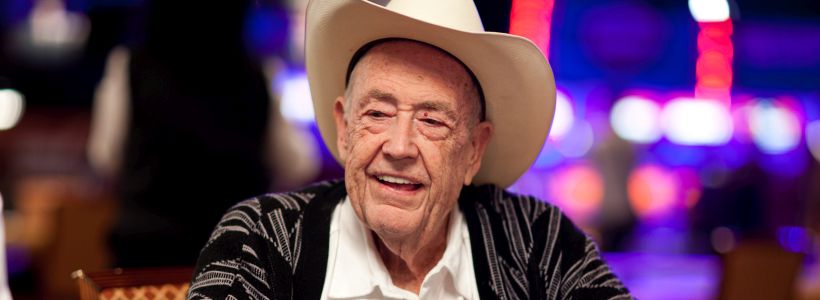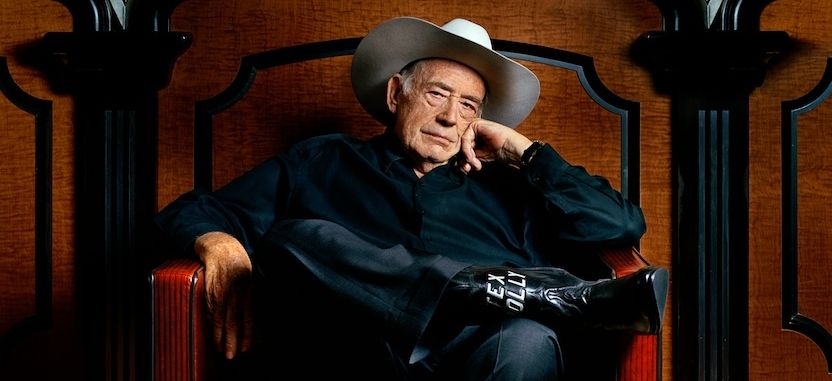
Doyle Brunson, "The Godfather of Poker", a true legend. Everyone respects and praises him for being able to stay on top of the poker world for many years.
That being said when you ask an average poker enthusiast about the best players in the game in terms of skill, Brunson's name is rarely mentioned.
It's all About the Long Run
The main argument for Doyle Brunson being one of the greatest players the game has ever known comes from the nature of the game itself. The role of the variance in poker is huge. Poker is a game where competent, but marginal winners can lose money for months on end, where a recreational player who has never even seen a starting hand chart can dominate the games for a few thousand hands or bink a big tournament.
Poker is a game where you can never know your actual win rate. In the context of our game the only test, that's worth a damn is the test of time and Doyle Brunson certainly passed it with flying colors.

Tight is Right
We all heard this old poker truth a thousand times and at some point in our journey, we start doubting it. How could playing a small selection of hands aggressively still be viable in the rapidly changing poker landscape? What about the shiny new software? What about the GTO? What about searching for every small edge possible?
The attraction to the more flashy or sexy parts of poker strategy causes many players to "put the cart before the horse" so to speak and sacrifice solid, profitable fundamentals. That was never true in Doyle Brunson's case. He's, after all, a Texan and knows exactly where the horse should stand in relation to the aforementioned cart.
Here's a quick example of how to get a fat, juicy edge over the likes of Daniel Negreanu without spending hundreds of hours with PioSolver of PokerSnowie. Fast play your aces and make sure to not pay him off when you're on the opposite side of this spot.
Benefits of a Tight Image
In this particular hand vs. David Benefield, Doyle manages to find a very profitable spot simply because other players are willing to respect his call/call/raise line so much given his image. When you see Doyle standing up to count your chips after you fired your third barrel, trips suddenly stop looking as attractive as they looked up so far.
Here's the thing, even though Doyle might have misjudged this particular situation it doesn't really matter. If we look at this spot EV wise, value raising KJ might be good, but if it is, it's also very very thin given the paired board texture (it's hard to find many combos that can pay off KJ). Even calling the river bet might not be good vs. some players (how many people would triple barrel KQ for value against Doyle Brunson?).
However, if Doyle's river raise can take care of both triple barrel bluffs and some % of villain's value range (it's unclear which 6x combos Raptor is folding) it's a great play no matter the holding. The fact that Doyle managed to avoid paying villain off with KJ makes it even better.
Another hand that shows how beneficial a well established tight image can be. How many people would think about including random trash like 82o in Brunson's 3betting range? Not many, and the fact that Doyle realizes that makes him extremely dangerous.
Unconscious Competence
Many great live players who spent a lot of time behind a poker table share this amazing trait. Just like the other great old school players Brunson is capable of reading the table dynamics perfectly using his tremendous experience.
Doyle isn't really known for light call downs, but he's capable of them if the situation calls for it. His perfectly aware of what other players think about his game and if we combine that knowledge with a dry board texture where villain can't really have that many value combos, plus Doyle's uncanny ability to read other players we get this somewhat uncharacteristic but very good play.
When the Table Play's Loose...
It would be easy to assume that someone like Doyle would get crushed by young poker players who have the chance of both learning and playing poker at a rate that's so much faster than what was available to the old school players back in the day. Fortunately for Doyle, the ultra-aggressive play that seemed to be all the rage a few years back doesn't really work that great against a tight competent style of play.
Sure, the loose-aggressive opponent can take advantage of the small leaks of a tight player and make a profit against him over the long run, but he can't really make his ranges weaker and if he's not careful he's bound to be on a losing side of big pots.
In this particular example, it's very difficult for Dwan to accept the fact that any player can have a strong range on this board texture because it doesn't go with what we knew about optimal poker strategy at the time. Fortunately for Doyle, he doesn't care about the shiny new tech, he just cares about making money. While his ranges might not be perfectly balanced and while his bluffing frequency might be too low in big spots it doesn't matter that much when he's able to get paid off by very competent players like Durrrr.
Another, less spectacular but similar example. "Who has a strong range in a tournament on a 258 board after cold calling preflop?" - is what Behbehani might have been thinking.
Mixing it Up
In this famous High Stakes Poker hand, Doyle had the displeasure of playing against someone on a high enough level of skill to recognize the inconsistency in his line, but most players would let the Godfather of Poker get away with murder.
The fact that Doyle is aware of that and isn't afraid to mix it up from time to time makes him very dangerous at the table. It's one thing to play against a tight ABC player and steal the small and medium sized pots that his strategy isn't that well set-up to defend, it's entirely different to play against a competent TAG who will both best you in most of the big pots and put you to the test in the mid-size ones where you still have to respect his range advantage.
The fact that Doyle Brunson can still play and win against the best of them is beyond impressive. It's a great achievement that shouldn't be overlooked. Labeling "The Godfather of Poker" as "just another TAG" is a grave mistake that many people playing against him made causing them to lose a bunch of money.
 More Top Rated Content
More Top Rated Content
Articles
Coaching Videos

